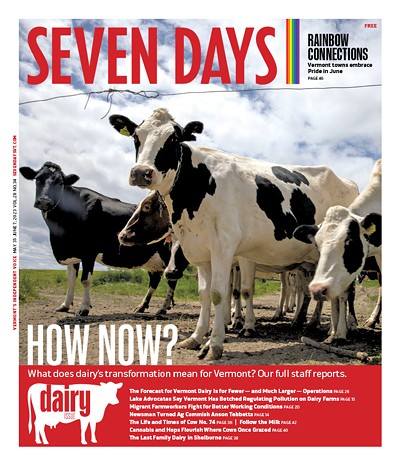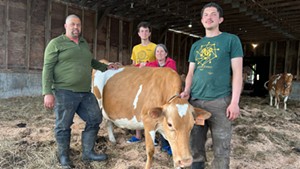
- James Buck | Rev. Diane Sullivan
Dairy farming occupies three-quarters of Vermont's working agricultural landscape and has been a leading industry since the 19th century. Its impacts are all around us: the rolling green pastures and ramshackle, slate-roofed barns; the smell of manure on fields in springtime; and, of course, creemees.
Whether we see, taste or smell it every day, dairy has become an integral part of the state's identity. The association is not unfounded. Little Vermont stands tall in the wider industry, at least in the Northeast. In the federal "milk marketing order" that includes New Jersey, upstate New York and most of New England, two Vermont counties — Addison and Franklin — were among the top 10 milk producers last year, federal data show.
But that doesn't mean dairy farming remains a commercially viable enterprise. The curious economics of the industry incentivize production, which keeps milk cheap — and plenty of Vermont farmers struggling. The state has long provided them assistance, including tax exemptions and help addressing their environmental problems. State Auditor Doug Hoffer's office said in a 2021 report that from 2010 through 2019, support for dairy farms cost Vermont more than $285 million.
Today, many farms rely heavily on cheap migrant workers — and still have trouble turning a profit. Dairy also contributes much of the nutrient-rich runoff that fouls Vermont's waterways.
There's no avoiding the question: Is dairy worth saving?
So, we devoted an entire issue to it.
Kirk Kardashian's cover-length story, "'Get Big or Get Out,'" recounts how dairy came to be so important in Vermont, the relentless march toward ever-bigger farms and what's likely in store in the future. One takeaway: Vermont could become more important to national food security as droughts threaten regions to the west.
Despite the importance of dairy farms, Vermont has stumbled in its attempts to regulate them — and their handling of massive amounts of manure, environmentalists contend. Some believe that the state's Agency of Agriculture, Food and Markets, which both promotes and regulates dairy, has a fundamental conflict of interest, Kevin McCallum reports.
We also write about dairy's open secret: the migrant laborers, many undocumented, who toil for long hours at difficult, dirty jobs. Derek Brouwer explains how the industry came to rely upon these workers and why they lack basic jobsite protections.
We caught up with Agriculture Secretary Anson Tebbetts, who grew up on a dairy farm and previously led the newsroom at WCAX-TV. He's still telling stories, though now they're all about agriculture. In a profile by Colin Flanders, Tebbetts restates advice he gives farmers: There are benefits to sharing their "authentic" experiences with the public.
Have you ever wondered where the milk these farmers produce winds up? People are drinking less milk but consuming more dairy, so much of the state's commodity is being turned into products such as yogurt and cheese — and even ghee and eggnog, Melissa Pasanen reports.
She also visited the last family dairy in Shelburne, on busy Dorset Street, and describes why the Maille family has kept at it, even as neighboring dairies sold their herds.
What's happening with all the properties where cows no longer graze? Rachel Hellman and Jordan Barry talked to farmers who have found new uses for former dairy farms, such as growing mealworms, hops and cannabis.
Sally Pollak teamed up with graphic artist Rick Veitch to illustrate the life of a dairy cow, a Holstein known simply as No. 74. Anne Wallace Allen wrote about a new visitors' center at a landmark yellow barn in Hardwick that will sell Cabot Creamery merch and showcase the area's agricultural history.
Our art critics weighed in on the subject, too. And Strafford Organic Creamery gets a close-up in this week's episode of Eva Sollberger's "Stuck in Vermont" video series.
It took a lot of hands to churn this issue out. Drink up.






Comments
Comments are closed.
From 2014-2020, Seven Days allowed readers to comment on all stories posted on our website. While we've appreciated the suggestions and insights, right now Seven Days is prioritizing our core mission — producing high-quality, responsible local journalism — over moderating online debates between readers.
To criticize, correct or praise our reporting, please send us a letter to the editor or send us a tip. We’ll check it out and report the results.
Online comments may return when we have better tech tools for managing them. Thanks for reading.